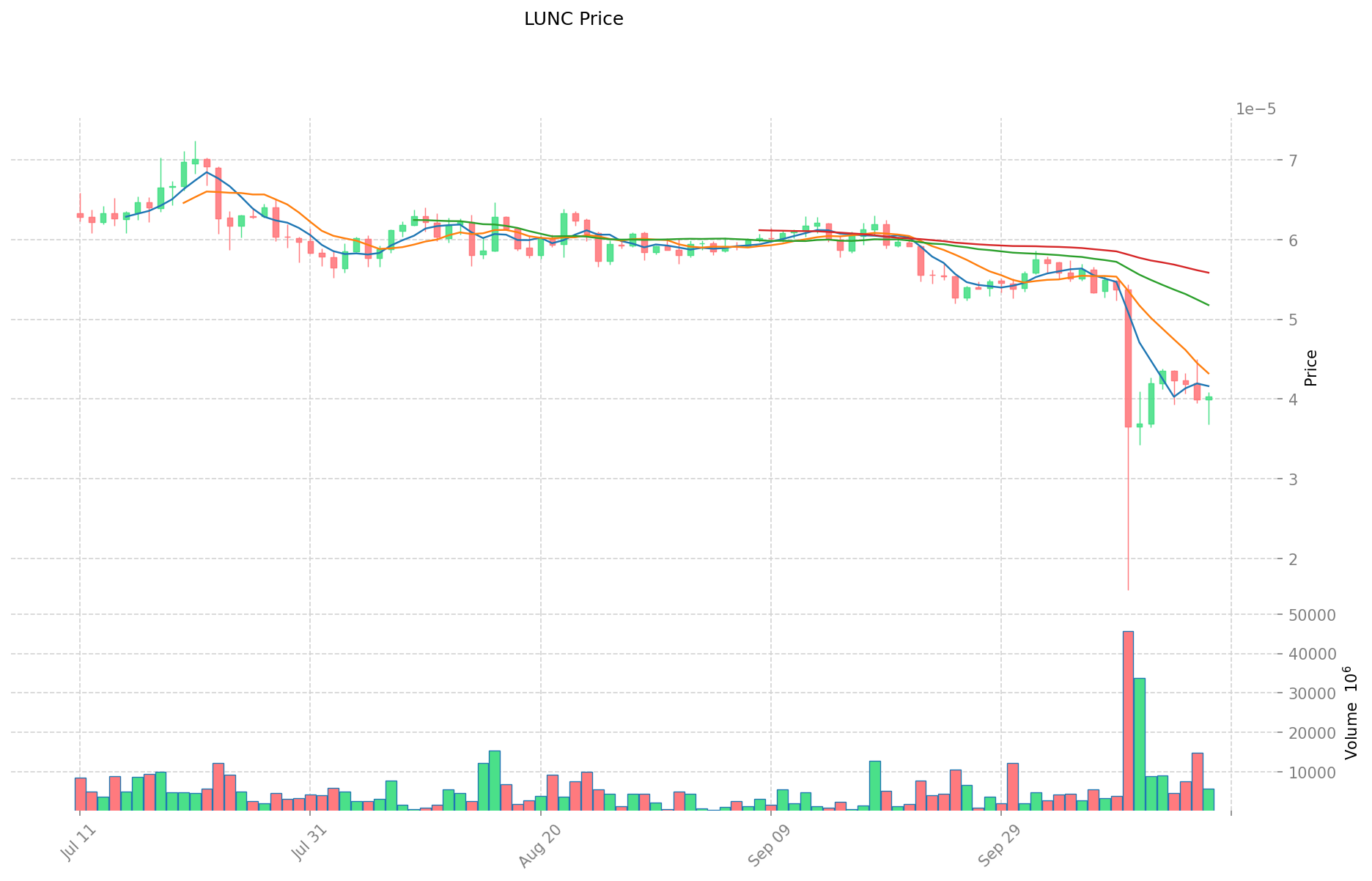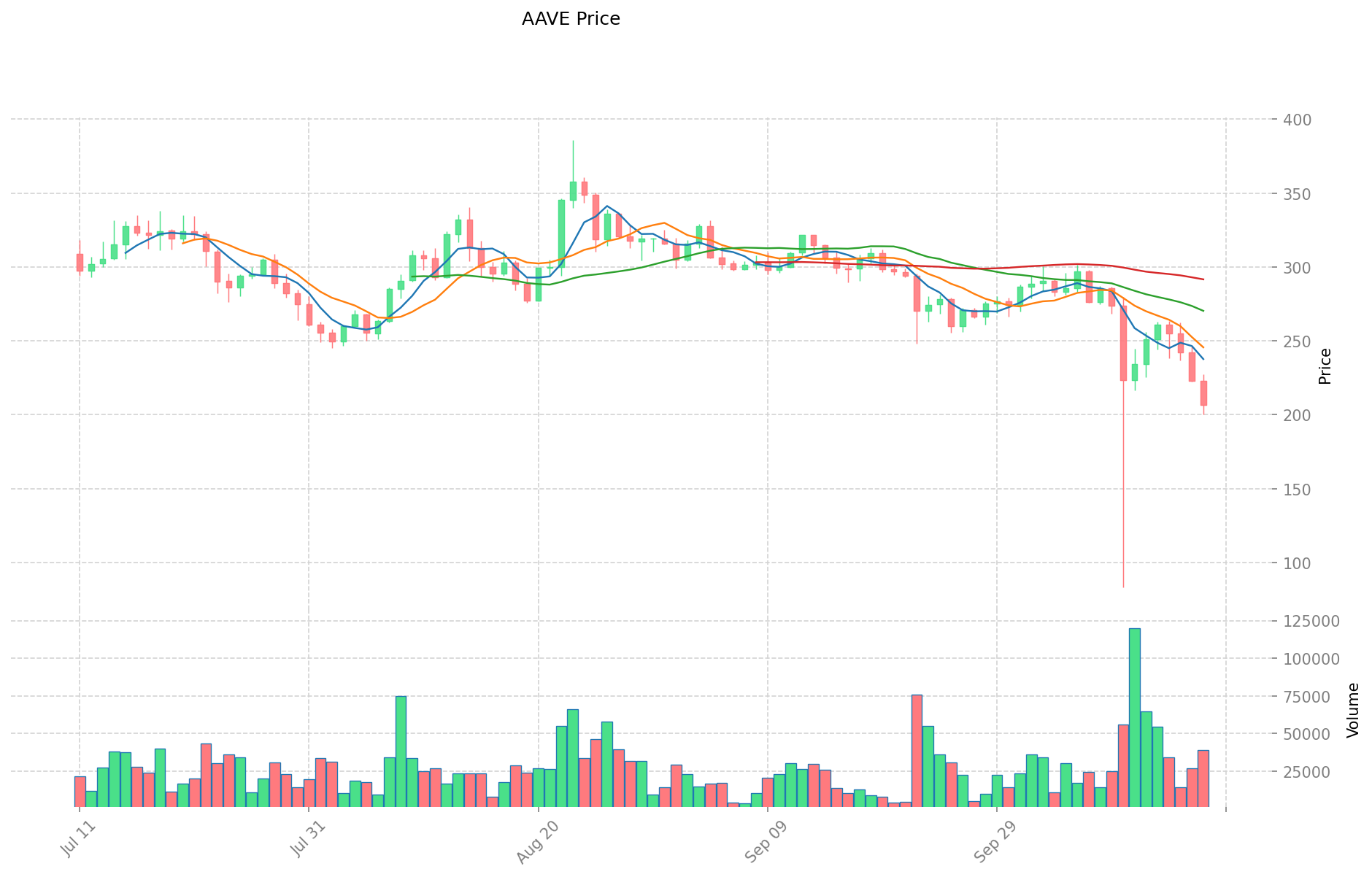LUNC ve AAVE: DeFi Ekosisteminde İki Kriptoparanın Hikayesi

Giriş: LUNC ve AAVE Yatırım Karşılaştırması
Kripto para piyasasında LUNC ile AAVE arasındaki karşılaştırma, yatırımcıların gündeminden hiç düşmeyen bir başlık olarak öne çıkıyor. İki varlık, hem piyasa değeri sıralaması, kullanım alanları ve fiyat performansı bakımından belirgin şekilde ayrışıyor hem de kripto varlıklar ekosisteminde farklı bir konumlanma sergiliyor.
Terra Classic (LUNC): 2020’de piyasaya sürülmesinden bu yana algoritmik stablecoin platformu olarak piyasanın ilgisini çekti.
AAVE (AAVE): 2020’de tanıtıldığından beri merkeziyetsiz kredi protokolü olarak öne çıkıyor; kullanıcılara mevduat ve kredi hizmetleri sunuyor.
Bu makalede LUNC ve AAVE’nin yatırım değerlerini, fiyat geçmişi, arz mekanizmaları, kurumsal benimseme, teknik ekosistem ve gelecek öngörüleri çerçevesinde kapsamlı biçimde analiz ediyoruz. Ayrıca yatırımcıların en çok merak ettiği soruya yanıt arıyoruz:
"Şu anda hangisi daha avantajlı bir alım?"
I. Fiyat Geçmişi Karşılaştırması ve Güncel Piyasa Tablosu
LUNC (Coin A) ve AAVE (Coin B) Tarihsel Fiyat Eğilimleri
- 2022: LUNC, Terra ekosisteminin çöküşüyle büyük bir değer kaybı yaşadı ve fiyatı 119,18 $ seviyesinden neredeyse sıfıra düştü.
- 2021: AAVE, 19 Mayıs 2021’de 661,69 $ ile rekor kırdı; bu yükselişte genel kripto boğa piyasası ve DeFi protokollerinin artan kullanımı etkiliydi.
- Karşılaştırmalı analiz: LUNC, tüm zamanların en yüksek seviyesi olan 119,18 $’dan en düşük 0,000000999967 $’a kadar gerilerken; AAVE, piyasaya çıktığı günden bu yana 26,02 $’ın üzerinde daha istikrarlı bir fiyat korudu.
Güncel Piyasa Durumu (18 Ekim 2025)
- LUNC güncel fiyatı: 0,00004027 $
- AAVE güncel fiyatı: 206,57 $
- 24 saatlik işlem hacmi: LUNC 219.621,09 $ | AAVE 8.155.980,94 $
- Piyasa Duyarlılığı Endeksi (Korku & Açgözlülük Endeksi): 23 (Aşırı Korku)
Canlı fiyatları görmek için tıklayın:
- LUNC güncel fiyatı: Piyasa Fiyatı
- AAVE güncel fiyatı: Piyasa Fiyatı


II. LUNC ve AAVE Yatırım Değerinde Etkili Temel Faktörler
Arz Mekanizması Karşılaştırması (Tokenomik)
-
LUNC: Terra çöküşü sonrası başlatılan token yakım mekanizmasıyla deflasyonist model; yaklaşık 6,9 trilyon toplam arz
-
AAVE: 16 milyon ile sınırlı arz, enflasyonsuz; protokol ücretlerinin %80’i token yakımında kullanılıyor
-
📌 Tarihsel Örüntü: Deflasyonist mekanizmalar boğa piyasalarında yukarı yönlü fiyat baskısı yaratabilir; ancak LUNC gibi çok büyük arzlar fiyat üzerinde anlamlı bir etki için güçlü piyasa katılımı gerektiriyor.
Kurumsal Benimseme ve Piyasa Uygulamaları
- Kurumsal Varlıklar: AAVE, önde gelen DeFi kredi protokolü olarak kurumsal yatırımcıların ilgisini çekiyor; LUNC ise çöküş sonrası güven sorunuyla mücadele ediyor
- Kurumsal Kullanım: AAVE, birçok DeFi ekosisteminde yer alıyor ve farklı blokzincirlerde kredi işlemlerini destekliyor; LUNC’nin kurumsal uygulama alanı ise oldukça sınırlı
- Regülasyon Yaklaşımı: AAVE, DeFi alanında genel regülasyon denetimiyle karşı karşıya olsa da merkeziyetsiz protokol olarak faaliyet gösteriyor; LUNC ise Terra ekosisteminin çöküşü nedeniyle ek regülasyon riskleri taşıyor
Teknik Gelişim ve Ekosistem İnşası
- LUNC teknik güncellemeleri: Topluluk odaklı yönetişim, vergi yakım mekanizmaları ve ekosistemi yeniden inşa çalışmaları
- AAVE teknik geliştirmeleri: V3 protokolü, GHO stablecoin ve zincirler arası entegrasyonlar üzerinde sürekli yenilik
- Ekosistem karşılaştırması: AAVE, birden fazla blokzincirde güçlü DeFi kredi ekosistemi sunarken; LUNC, sınırlı geliştirici faaliyetiyle toparlanma yolunda
Makroekonomik ve Piyasa Döngüleri
- Enflasyon Dönemlerinde Performans: AAVE, DeFi getiri arayışının öne çıktığı dönemlerde avantaj sağlayabilir; LUNC’nin net bir enflasyon koruma işlevi yok
- Makro Para Politikası: Faiz artışları AAVE’nin kredi faaliyetlerini etkileyebilir; her iki token de genel kripto piyasası ile para politikası korelasyonu gösterir
- Jeopolitik Etkiler: AAVE’nin merkeziyetsiz kredi altyapısı sınır ötesi fayda sunarken; LUNC’nin uluslararası itibarı ekosistem çöküşüyle ciddi biçimde zarar gördü
III. 2025-2030 Fiyat Tahmini: LUNC vs AAVE
Kısa Vadeli Tahmin (2025)
- LUNC: Muhafazakar 0,0000294993 $ - 0,00004041 $ | İyimser 0,00004041 $ - 0,0000517248 $
- AAVE: Muhafazakar 167,5971 $ - 206,91 $ | İyimser 206,91 $ - 221,3937 $
Orta Vadeli Tahmin (2027)
- LUNC büyüme fazına girebilir; beklenen fiyat aralığı 0,00005240627424 $ - 0,0000600488559 $
- AAVE boğa piyasasına geçebilir; beklenen fiyat aralığı 135,30113883 $ - 303,174774045 $
- Temel belirleyiciler: Kurumsal sermaye girişi, ETF gelişimi, ekosistem büyümesi
Uzun Vadeli Tahmin (2030)
- LUNC: Temel senaryo 0,000046283178382 $ - 0,000079798583418 $ | İyimser senaryo 0,000079798583418 $ - 0,000094960314268 $
- AAVE: Temel senaryo 200,704198477705065 $ - 295,153233055448625 $ | İyimser senaryo 295,153233055448625 $ - 374,844605980419753 $
Feragatname: Bu bilgiler yalnızca bilgilendirme amaçlıdır, finansal danışmanlık yerine geçmez. Kripto para piyasası aşırı dalgalı ve tahmin edilemezdir. Yatırım öncesi mutlaka kendi araştırmanızı yapınız.
LUNC:
| Yıl | Tahmini En Yüksek Fiyat | Tahmini Ortalama Fiyat | Tahmini En Düşük Fiyat | Değişim Oranı |
|---|---|---|---|---|
| 2025 | 0,0000517248 | 0,00004041 | 0,0000294993 | 0 |
| 2026 | 0,000063112338 | 0,0000460674 | 0,000023955048 | 14 |
| 2027 | 0,0000600488559 | 0,000054589869 | 0,00005240627424 | 35 |
| 2028 | 0,000079673913805 | 0,00005731936245 | 0,000055026587952 | 42 |
| 2029 | 0,000091100528709 | 0,000068496638127 | 0,000034933285445 | 70 |
| 2030 | 0,000094960314268 | 0,000079798583418 | 0,000046283178382 | 98 |
AAVE:
| Yıl | Tahmini En Yüksek Fiyat | Tahmini Ortalama Fiyat | Tahmini En Düşük Fiyat | Değişim Oranı |
|---|---|---|---|---|
| 2025 | 221,3937 | 206,91 | 167,5971 | 0 |
| 2026 | 286,963479 | 214,15185 | 124,208073 | 4 |
| 2027 | 303,174774045 | 250,5576645 | 135,30113883 | 21 |
| 2028 | 293,47819242885 | 276,8662192725 | 166,1197315635 | 34 |
| 2029 | 305,13426026022225 | 285,172205850675 | 222,4343205635265 | 38 |
| 2030 | 374,844605980419753 | 295,153233055448625 | 200,704198477705065 | 43 |
IV. LUNC ve AAVE Yatırım Stratejisi Karşılaştırması
Uzun Vadeli ve Kısa Vadeli Yatırım Stratejileri
- LUNC: Ekosistem toparlanma potansiyelini hedefleyen yüksek riskli yatırımcılar için uygun
- AAVE: DeFi büyümesinden ve protokol istikrarından yararlanmak isteyen yatırımcılar için uygun
Risk Yönetimi ve Varlık Dağılımı
- Muhafazakar yatırımcı: LUNC %5 | AAVE %95
- Agresif yatırımcı: LUNC %30 | AAVE %70
- Koruma araçları: Stablecoin tahsisi, opsiyonlar, çapraz döviz portföyleri
V. Potansiyel Risk Karşılaştırması
Piyasa Riskleri
- LUNC: Yüksek volatilite, düşük likidite ve piyasa duyarlılığına karşı kırılganlık
- AAVE: Genel DeFi piyasası performansı ve kripto döngüleriyle korelasyon
Teknik Riskler
- LUNC: Ekosistem toparlanma zorlukları, sınırlı geliştirici katılımı
- AAVE: Akıllı kontrat açıkları, Ethereum’daki ölçeklenebilirlik sorunları
Regülasyon Riskleri
- Küresel regülasyon politikaları, LUNC (geçmişi gereği) ile AAVE (DeFi protokolü olarak) üzerinde farklı etkiler yaratabilir
VI. Sonuç: Hangisi Daha Avantajlı Bir Alım?
📌 Yatırım Değeri Özeti:
- LUNC avantajları: Deflasyonist yapı, yüksek risk/yüksek getiri potansiyeli
- AAVE avantajları: Kurumsal benimseme, köklü DeFi protokolü, sürekli teknik gelişim
✅ Yatırım Tavsiyesi:
- Yeni yatırımcılar: DeFi sektörüne daha istikrarlı erişim için AAVE’yi değerlendirin
- Tecrübeli yatırımcılar: Ağırlıklı olarak AAVE, daha az miktarda LUNC ile dengeli portföy oluşturun
- Kurumsal yatırımcılar: DeFi’deki konumu ve regülasyon uyumu sayesinde AAVE’ye odaklanın
⚠️ Risk Uyarısı: Kripto para piyasası aşırı volatiliteye sahip olup, bu makale yatırım tavsiyesi değildir. None
VII. Sıkça Sorulan Sorular
S1: LUNC ile AAVE arasındaki başlıca farklar nelerdir? C: LUNC, yüksek arz ve deflasyonist mekanizma ile eski bir algoritmik stablecoin platformudur; AAVE ise sınırlı token arzına sahip merkeziyetsiz bir kredi protokolüdür. AAVE, istikrar ve kurumsal benimseme açısından önde; LUNC ise büyük bir piyasa çöküşünden toparlanmaya çalışıyor.
S2: Hangi token tarihsel olarak daha iyi fiyat istikrarı gösterdi? C: AAVE, istikrar bakımından daha iyi performans sergiledi. Dalgalanmalar olsa da, piyasaya çıktığından beri 26,02 $ üstünde kaldı. LUNC ise 119,18 $ ile zirveye çıkıp neredeyse sıfıra kadar gerileyerek sert bir çöküş yaşadı.
S3: LUNC ile AAVE’nin arz mekanizmaları nasıl farklı? C: LUNC, yaklaşık 6,9 trilyon toplam arz ve token yakım mekanizmasıyla deflasyonist bir model sunuyor. AAVE ise 16 milyon ile sınırlı arz, enflasyonsuz ve protokol ücretlerinin %80’i token yakımına ayrılıyor.
S4: Hangi token kurumsal benimsemede önde? C: AAVE, önde gelen DeFi kredi protokolü olarak kurumsal yatırımcıların ilgisini çekiyor. Birçok DeFi ekosistemiyle entegre ve farklı blokzincirlerde kredi işlemlerini sağlıyor. LUNC ise çöküş sonrası güven sorunu yaşadığından kurumsal uygulaması oldukça az.
S5: LUNC ve AAVE’nin gelecekteki fiyatını etkileyen başlıca faktörler neler? C: Kurumsal sermaye girişi, olası ETF onayları, ekosistem büyümesi, regülasyon değişiklikleri, genel kripto piyasa koşulları ile enflasyon ve faiz gibi makroekonomik etkenler ana belirleyicilerdir.
S6: LUNC ile AAVE için yatırım stratejileri nasıl ayrışıyor? C: LUNC, yüksek riskli ekosistem toparlanma odaklı yatırımcılar için daha uygun; AAVE ise DeFi büyümesi ve protokol istikrarı arayanlar için ideal. Muhafazakar yatırımcılar LUNC’ye %5, AAVE’ye %95 ayırabilir; agresif yatırımcılar için %30 LUNC, %70 AAVE dağılımı düşünülebilir.
S7: LUNC ve AAVE yatırımlarında öne çıkan başlıca riskler nelerdir? C: LUNC, aşırı volatilite, düşük likidite ve ekosistem toparlanma zorluklarıyla karşı karşıya. AAVE ise genel DeFi piyasa performansına bağlı riskler, olası akıllı kontrat açıkları ve regülasyon denetimiyle karşı karşıya. Her ikisi de genel kripto piyasası riskleri ve mevzuat belirsizliğinden etkilenir.

2025 RSR Fiyat Tahmini: Piyasa Trendleri, Teknolojik Gelişmeler ve Regülasyonun RSR’nin Gelecekteki Değeri Üzerindeki Etkisi

RESOLV ve UNI: DeFi Ekosisteminde Merkeziyetsiz Likidite Çözümlerine Yönelik İki Devrimci Yaklaşımın Karşılaştırılması

2025 USDE Fiyat Tahmini: Dijital Para Birimi Ekosisteminde Gelecek Trendlerin ve Piyasa Potansiyelinin Analizi

2025 TUSD Fiyat Tahmini: Düzenlenmiş Kripto Ekonomisinde Stablecoin Eğiliminin Analizi

2025 RSR Fiyat Tahmini: Reserve Rights Token’ın Gelecek Piyasa Potansiyeli ve Büyüme Faktörlerinin Analizi

USUAL nedir: Sistemler Kullanıcı Kimlik Doğrulama Yaşam Döngüsünü Anlamak







